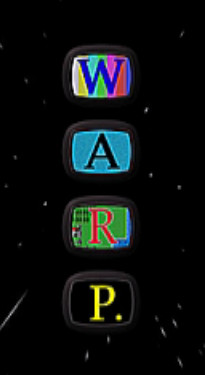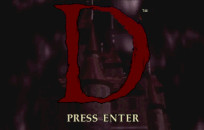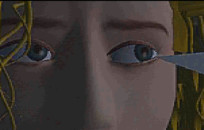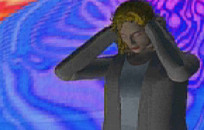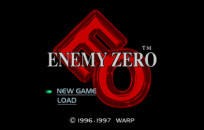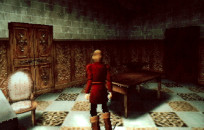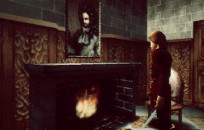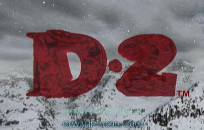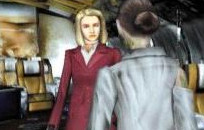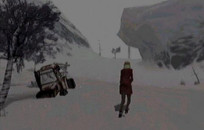Kenji Eno
Feel the different culture
on the backside of the Earth

COREgaming
- 21 / 08 / 08
II. ECLIPSE
After some wearisome years in the production of late Nintendo Famicom cartridges between 1991 and 1993 with EIM, Eno took a small break from the videogames industry to become a collaborator in an automobile magazine, where he kept in touch with the latest developments of the digital world. In his visits to the United States he learned about the new trends flourishing on the inside world of electronics and software companies, the so-called “cool” and “relaxed” approach to business as opposed to the highly rigid a severe character of the Japanese business world. Subsequently, this was one of the main reasons behind the foundation of his new studio, WARP, initially based on the new platform created by the charismatic Trip Hawkins - the ephemeral 3DO.
Hawkin’s new and resourceful enterprise was opening a new branch in Japan and was very receptive to the projects and ideas shown by Kenji Eno. In addition, the new console was based on the CD-ROM format, an inexpensive technology that allowed smaller companies to release their products to a larger audience, unlike the steep-priced cartridges. Therefore, WARP was founded not only as a consequence of the modern system which Trip Hawkins and 3DO brought to Japan, but also as an outcome of the Compact Disk age, with its low production costs and smaller investment risks.
Even if the European and North-American market would only know the work of Eno as a founder and producer of the game D (or D'S DINNER TABLE) in the mid nineties, the Japanese market was more than one year ahead with games like TOTSUGEKI KARAKURI MEGADESU!!, a strange first person fighting game, and FLOPON WORLD (or TRIP'D), a multiply released puzzle title. On the years to come, the japanese market was also presented with other exclusive releases such as OYAJI HUNTER MAHJONG (1995) or SHORT WARP (1996), a visionary celebration of the WARP's imaginary in the form of different mini-games.
D was, however, the true and mature title that consecrated Eno as an author capable of exploring an interactive drama using the potential of pre rendered graphics and animations. In a daring attempt to disrupt the customary practice of shooting real actors against a blue screen, WARP gave birth to Laura, one of the first virtual actresses to star in a videogame. In order to suggest complex emotions, the synthespian’s facial elements were highly malleable and therefore capable of providing different expressions.
Even if the mechanics for this game were very much inspired by the old genre of the graphical adventure, D used state-of-the-art technology. Remarkably, the narrative of Laura's search of her mass-mudering father was only inserted into the game when the project was already well under way: something which could account for the unusual storytelling method in the form of Laura’s memories and sudden flashbacks. As a thrilling cinematic experience, D was one of the first console games to present a truly mature themed atmosphere, with complex characters whose acts were defined by non-linear motivations.
Taking a break from the complexity of 3D models and fully animated sequences, Eno focused on his acute awareness for sounds as the starting point for the creation of an obscure Sega Saturn title: REAL SOUND: KAZE NO REGRET, meaning the Wind's Regret. Defined by the almost complete absence of images, this revolutionary game concept is said to have originated from Eno's contact with unsighted game enthusiasts - hence the unusual choise of including of a Braille written message inside the game package.
REAL SOUND was able to explore, along its four CD love story set in Tokyo, the hidden potential of a game that appeals to the discerning ear and mind. Instead of using visuals the predominant factor, WARP's project focused solely on the wonderfully written script featuring a luxurious voice cast. Rejecting a number of preconceptions on how a videogame should function, this title also proved to be essential in the establishment of WARP's identity as an autonomous company with unique creative perspectives.
In 1997, the concept of interactive movie was renewed with the title ENEMY ZERO, a space adventure that pays direct homage to renowned science fiction cinema and literature classics. In this second rendering of the virtual actress Laura, the studio worked on a remarkably smooth transition, counterpointing the pre rendered sequences with real time 3D - the ideal solution for the game’s new combat system. As the title so clearly indicates, the opposing threat consists of an alien breed, invisible to the human eye, that managed to permeate the interior of the Aki space station.
These creatures, classified as E0, can only be traced using a weapon that emits different tones according to the alien’s position or proximity: again, the use of sound as a protagonist in a WARP game. Apart from the undeniable technical feat, ENEMY ZERO also represents one of Eno’s major professional achievements as he contacted and persuaded the illustrious composer and pianist Michael Nyman to create the musical score.
The year of 1997 would, on the other hand, be the bearer of some major setbacks and misfortune to the studio. In a second attempt to enter the console market, a new 3DO 32-Bit system named M2 was developed and later sold to the Japanese company Matsushita (vulgarly know as Panasonic). Several titles were being planned and in fact executed for the M2, including a powerful line-up from Konami. Yet, in spite of the impressive hardware specifications, the Japanese electronics giant cancelled the console's release on account of the impenetrable market: Sony was surpassing even the best expectations projected for the Playstation; Nintendo 64's initial sales figures skyrocketed; and SEGA kept fighting for a generous portion of the market with their very own Saturn.
Among the titles planned for the launch of Panasonic M2 was D-2, an unusual sequel to the original 1995 WARP that was called off already in an advanced production stage. The images and videos collected so far seem to show a full 3D game with impressive visuals – possibly the best engine running on a home system at the time – as well as a very distinct presentation. Some argue that the game was a direct sequel to D, where Laura’s son was the main character trapped in a huge manor filled with otherworldly entities. The speculation around this unreleased game endures.
With the advent of the new 128-Bit console’s release in the Japanese market, the SEGA Dreamcast, Eno recaptures the experience of REAL SOUND: KAZE NO REGRET in a whole new release of the game. Apart from the "classic mode", previously used in the Saturn version, the studio added a whole new "visual mode", including images and photos created by Eno himself. This original sound drama, released in the same year as the console, also came to be known for a small extra that was included within the game box named D-2 SHOCK!, a unique GD-ROM preview of the upcoming WARP release.
As a result of the good professional relationship between with SEGA and WARP, Eno reconsiders his plans for the D-2 project and decides to go ahead with an all new and alternative version for the Dreamcast, released in 2000. Laura, which seemed to have but a supporting role in the original project for the M2, assumed once again the role as the main character in this plot set in the snowy Canadian wilderness.
Of the features Eno invested the most in this early Dreamcast title was the creation of a cunningly written script with elusive dialogues. The predominantly white background featured in the game was created using full 3D graphics, for the first time ever in a WARP project, leaving the use of CGI exclusively for a few detailed cut-scenes.
D-2 was launched in Japan and later in the US, uniting several game genres in one: action, adventure and RPG elements. Surprisingly, the interior spaces were explored in a subjective perspective, evoking with great accuracy the genre and game play previously explored in the first D title – such was the detail of the 3D engine created by this team. The high-production values, puzzling narrative and unique ambience, along with Eno's exquisite music score, resulted in one of the best horror and paranormal-themed videogame experiences to ever appear on a console.
After more than five years as an active studio, all these efforts weren’t enough to keep the group alive, leading Eno to the decision to broaden WARP’s market range. For a while, the renewed SUPER WARP dealt with other media contents such as DVD, networking or online music until it finally faded not long after, never again to produce or release a videogame. As a self-reliant creative power, WARP enunciated a new paragraph in the chapter of Japanese independent videogame market, branded by the irreverence of its multifaceted founder and leader.
WARP (highlights) D (1995, 3DO / Saturn / Playstation)
A well known and respected doctor has committed a series of murders, locking himself up inside a hospital. His daughter, Laura, enters the vicinities in order to meet him and find the reason behind this aberrant and inexplicable behavior. In its day, D became a benchmark in horror adventure games not only due to the sheer beauty of the graphics, but because of the unique atmosphere that inspired latter videogames such as the original Resident Evil. Another crucial feature was the timed game play, which only allowed the player two hours to complete the game - the game time could actually be read in Laura's watch. Short Warp (1996, 3DO)
One of the japanese market exclusives, Short Warp was designed to be a different game from the start. It consisted of a compilation of mini games alluding to WARP's previous products. This is, without a doubt, Eno's most eccentric game of all time. Real Sound
One of WARPs most ingenious products, Real Sound tried to bring videogames and the visually impaired together by concentrating uniquely on the sound. The story, to those who have had the chance to discover it, is said to be truly fascinating - on a different level than any other videogame released in its day. Real Sound Kaze No Regret (The Wind's Regret) was released years after for the Dreamcast featuring some still visuals composed of photos taken by Eno himself. Enemy Zero (1997, Saturn / PC)
Following Eno's break-up with Sony, Enemy Zero, the spiritual successor to D, was only released on the Sega Saturn (and later the PC) where it soon became a cult hit. Apart from the contribution of the composer Michael Nyman, E0 is still remembered for its fascinating narrative. Laura was once again summoned in Enemy Zero, only this presenting a new look. Apart from the platform shift surprise, this title also became controversial due to the very brief but highly artistic nudity scenes involving the fair-haired vactor. Some high resolution images are available here. D-2 (Unreleased, Panasonic M2)
D-2 for the M2 was never released because Panasonic pulled the plug on the project just before its scheduled release. Boasting a wonderful art direction and impressive visuals, this action adventure game in the form of a horror tale became one of the most legendary non-released videogames in history. D2 (2000, Dreamcast)
Following the release of KAZE NO REGRET, D-2 for the Dreamcast became a different game from the original M2 project. Eno was inspired by the snowy mountains of New Zealand in one of his travels to create a new hostile environment such as the one seen in the game - played in the wilderness of Canada after a plane crash. D-2's mystifying narrative places Laura once again in direct contact with the paranormal, while dealing with very complex themes that are sure to elude the majority of videogame players. |

